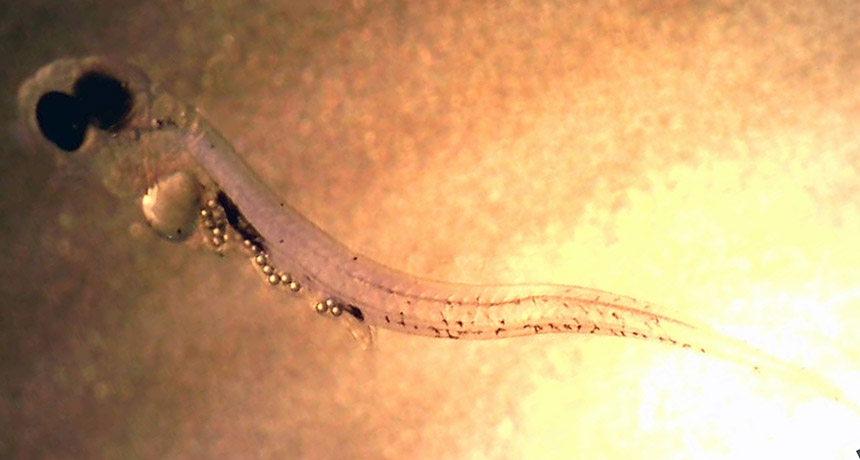- Home
- >
- Mermaid tears are killing European sea bass
-

胃裡塞滿塑膠微粒的幼魚。圖片來源:ScienceNews
A recent study has found that microplastics, often referred to as "mermaid tears," are causing significant harm to European sea bass populations. These tiny plastic particles, measuring less than 5 mm in size, make their way into the oceans through various sources such as industrial and domestic waste.
When ingested by the fish, these microplastics can accumulate in their digestive systems, leading to various health issues. The toxins present in the microplastics can cause liver and kidney damage, disrupt the fish's hormonal balance, and weaken their immune system. Long-term exposure to microplastics can ultimately lead to the death of these marine creatures.
This discovery highlights the urgent need to address plastic pollution and its impact on marine ecosystems. Efforts should focus on reducing plastic waste, improving waste management systems, and promoting sustainable practices to ensure the health and survival of marine species like the European sea bass.
In 2014, the world produced 311 million tons of plastic. Although 30% of plastic was recycled, another 40% was incinerated for energy generation, and the remaining 30% was sent to landfills [1].
During this process, a significant amount of plastic products end up as litter and start to float around. Some of this floating plastic is ingested by birds or marine organisms, causing them to become bloated and preventing them from feeding, ultimately leading to their death. The remaining plastic debris that is not ingested gradually breaks down and fractures over time, forming microplastic particles, also known as "mermaid tears."
The impact of these microplastic particles on organisms is still a subject of ongoing research. Some studies have shown that when organisms consume microplastics, they exhibit behavioral changes and disruption of lipid metabolism. However, detailed research in this area is still lacking.
To further investigate the effects of microplastic particles on organisms, a recent study conducted by researchers at Uppsala University used 90 μm polystyrene microplastic particles and European sea bass (Perca fluviatilis) as the study materials. The fish were exposed to two concentrations: 10,000 particles per cubic meter and 80,000 particles per cubic meter, which were based on average and high exposures found in Swedish waters, respectively. The researchers compared the fish exposed to these two concentrations with a control group that had no microplastic particles.
The study found that the fish in the high exposure group had reduced activity and lost their predator avoidance response. When the researchers introduced these fish to their predator, the pikeperch (Esox lucius), all of the high exposure group fish were consumed within 24 hours, while the survival rate of the average exposure group was 34% and the control group had a survival rate of 46%. Furthermore, despite being fed the same amount of shrimp, the high exposure group of European sea bass fry had their stomachs filled with microplastic particles, while the average exposure group had both microplastic particles and shrimp present in their stomachs. Even though the shrimp is the proper food source, the fish seemed to prefer the microplastic particles, resulting in the fry from both exposure groups being smaller than those in the control group. The length of the fish in the high exposure group was reduced by 9%, while the average exposure group showed a reduction of 3%.
In addition to affecting fish activity, predator avoidance behavior, and growth, the researchers also found that when European sea bass eggs were exposed to the highest concentration of microplastic particles, only 81% of the eggs successfully hatched, compared to a hatching success rate of 96% in the control group (89% in the average exposure group).
It is important to note that this study specifically used polystyrene microplastic particles, while there are several different types of plastic particles found in the oceans (e.g., PVC, polyethylene, polymethyl methacrylate [3]). Although other types of microplastic particles have varying degrees of harm to animals, the researchers mentioned that polystyrene was chosen because previous studies have shown that fish consuming polystyrene exhibit behavioral and metabolic changes [4]. Considering the overall abundance of microplastic particles in the oceans, which consists of various types of plastics, it is unknown whether results would be more severe or less severe using a single type of microplastic particle. Nonetheless, the findings from this study reflect a dose-response relationship, indicating that the higher the concentration of microplastic particles, the greater the impact on hatching rates, fry growth, and behavior.
Plastic has brought convenience to our lives since its invention in 1839 by Eduard Simon. However, if we do not carefully consider how to reduce plastic consumption and implement effective recycling practices, our bodies may become filled with plastic (in one form or another) in the future. Even before that point, our oceans and rivers will likely be filled with jellyfish and microplastic particles.
References:
- Plastics: the Facts 2015. Plastics Europe.
- Lonnstedt O.M. and Eklov P. 2016. Environmentally relevant concentrations of microplastic particles influence larval fish ecology. Science 352:1213-1216
- Browne M.A. et. al., 2015. Linking effects of anthropogenic debris to ecological impacts. Proc. Biol. Sci. 282: 20142929
- Karin Mattsson. 2015. Altered Behavior, Physiology, and Metabolism in Fish Exposed to Polystyrene Nanoparticles. Environ. sci. Technol. 49:553-561
Author: Yeh, Lu-Shu
Source: CASE News
